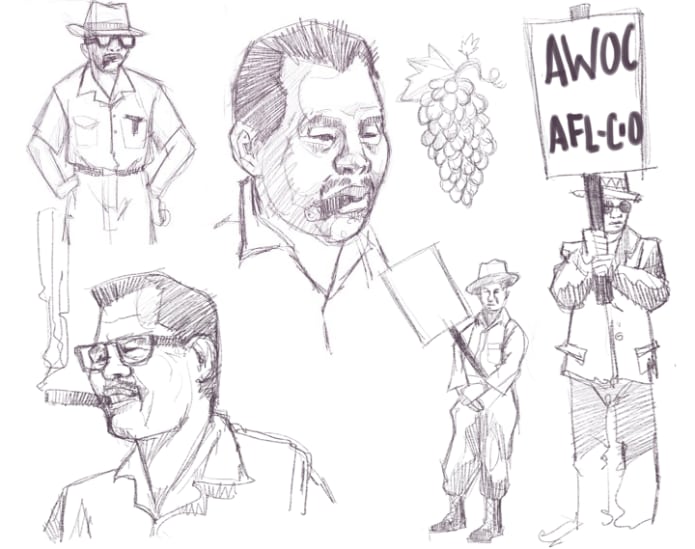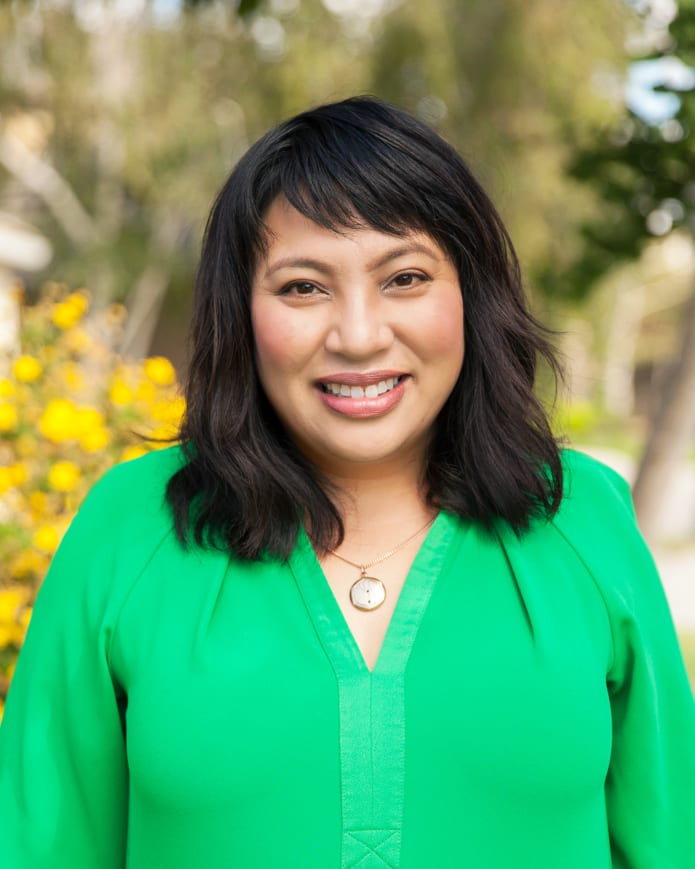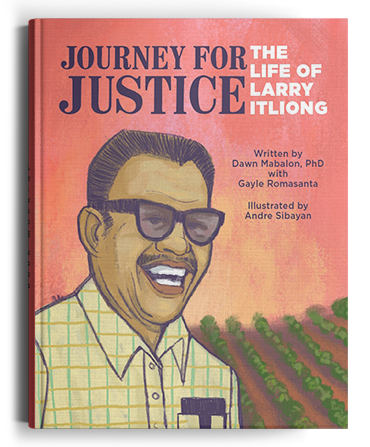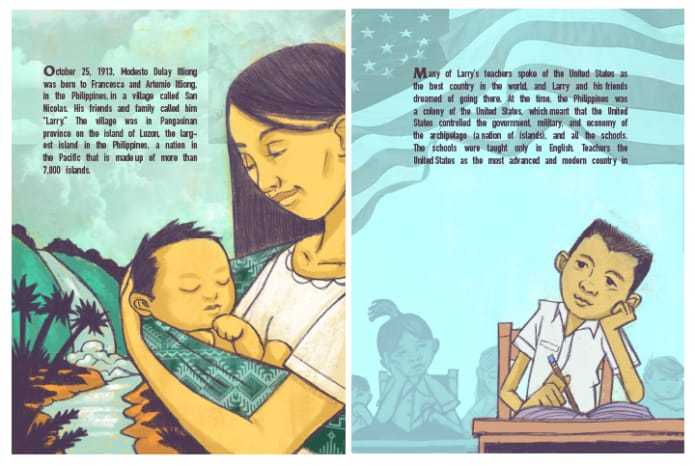One of the most fun things about creating Sari-Sari Storybooks has been learning about independent publishing. Part of that means meeting interesting niche publishers, who are making their own way, too. I don’t get to geek out about metadata and crowdfunding with just anyone! So here at Sari-Sari, we’ll be posting a monthly series of Q+A with other indie publishers, starting with our kasamas at Bridge + Delta. Below is an interview with Gayle Romasanta, the founder of Bridge + Delta.
They are currently running an Indiegogo until Nov 20, to fundraise for Filipino-American history books. Drop by to help fund stories about Larry Itliong, Victoria Manalo Draves, and Carlos Bulosan for kids: igg.me/at/journey-for-justice
 Illustrations by Andre Sibayan
Illustrations by Andre Sibayan
Tell me about Bridge + Delta. What’s your mission, in a nutshell?
Our mission is really about telling immigrant stories. Bridge + Delta Publishing brings us back to my family farmhouse in Brentwood, California, often filled with generations of families on its 11 acres of stories. To get there, we would travel from Stockton every weekend on a windy road that stretched along the dreams of migrant farmworkers. We would cross three bridges over the sprawling California delta when the feeling of almost there would overtake us … that feeling of almost home… where Lolo (Grandpa Vic), uncles, and tapioca pudding would be ready to welcome us.
Bridge + Delta was founded on the spirit of immigrant journeys that are absolutely American at their core. We publish stories for families and communities to understand their past, present and future, so that their immigration story gives them a better understanding of who they are. That way, our communities are not just almost home. They are home.
What motivated you to start Bridge + Delta Press?
I honestly could not find any Filipino-American history books for children! My daughter always gets sent home with a list of heroes she can do a report on. There are usually no Asians or Filipino-Americans on that list. With Filipino-Americans the largest Asian-American group in California and the second largest in the U.S., I felt there needed to be a change.
Why go indie with this project? Why not pitch it to a bigger publisher, that has more resources to offer? Or did you try that route already?
I think this issue is so important to address and I didn’t want to wait years to see books come out. I wanted them out within the year. I already had a difficult time finding publishers for my first children’s book (Beautiful Eyes). I’m not waiting years to find someone to say “yes” to a Filipino-American history book for children. The technology is already there for me to just create the solution now.
How much are you raising, and how will that money be used?
$35,000, but now we have a stretch goal of $40,000. Money from the campaign goes to production costs of the first four books in a series about Filipino-American leaders who changed US history. For sure we have enough money to pay for the first two books to be published (about Larry Itliong and Victoria Manalo Draves) .The rest of the money will go to any other production costs for books number three and number four. There will be eight books in the series.
You’re almost to your fundraising goal already. Where has most of your support come from?
Definitely the Filipino-American community. With 60+ years of working within the community among myself, Dawn and Dre, many of our friends and family were able to support us and be part of the movement. Donations also came throughout California and the United States to invest in the next generation. Thank you community!!!
I know that my Sari-Sari Storybooks “office” is a laptop and two cats in a corner of my Brooklyn apartment, or whatever coffee shop / friend’s home I land in on my travels. How about you? What does a working day at Bridge + Delta look like?
If I’m lucky, I get to be in my family room/dining room running Bridge + Delta. I do a lot of meetings through GoToMeeting with Gena Salonga, my sister and creative partner, and our other collaborators. But most days, I’m in my kitchen with two identical twin girls running around. It’s a stop-and-go production because of the kiddies (and the older kiddies that come home from school, which brings my brood to 4 kiddos). I seriously work around the clock. Once everyone goes to sleep, I’m back on my laptop.
As a mother raising Fil-Am children, what do you observe in them, when they read diverse books or see diverse films? Were they part of your inspiration?
I think a lot of my parenting and how my perspective affects my kids comes as they get older. You never truly know how you’re affecting them until you see them at school or interacting with other children or thinking on their own projects. I introduce many diverse books and perspectives in the house. They have also attended a summer school cooperative that helps them understand theirs and others’ immigration story. I make them read things like Alex Tizon’s Atlantic story about having a slave when he was growing up. I want them to feel and read and see things from a point of reflection and empathy. So, they’re exposed to many stories, books, movies that have that kind of impact. All the things I do are related so much to my family. My fiction as a writer, and now my work as publisher. Everything I do, my family is at the center of those decisions for me as a working artist/mommy/daughter/sister.
These aren’t just stories, but stories of Fil-Am heroes. Were there moments, in your own upbringing as a Fil-Am, where you wished for role models like these?
I didn’t know how to articulate it. But yes. There was really nothing I could look to growing up. I had to really just see my parents and my grandfather for who they were and have pride in them, because I understand how hard they had to work to thrive in the United States.
Book one will introduce us to Larry Itliong. Who else will we get to meet, through the Bridge + Delta series?
Victoria Manalo Draves and Carlos Bulosan are up next.
Who are you collaborating with?
Andre Sibayan, Dawn Mabalon and Ramon Abad are a few folks I’m working with. Gena Romasanta Salonga is also my creative partner.
What are some of the hard parts of being an independent publisher? What have you had to figure out along the way?
It’s really hit-or-miss. Everything you read or research says that publishing is changing all the time, and it is. How do you continue the work so that it resonates with your community, and is modern and accessible? It’s a big ask. No one in traditional publishing has attempted to publish Filipino-American history books for children. So it’s new for me and the community (imagine that?!! Still floored that’s the case).
What’s the best part about being indie?
It’s a reinvention and no one calls the shots but a collective we. It’s me and the community pushing this work through, and what an amazing concept that is.
Any advice for others wanting to go the independent publishing route?
Homework and research is necessary. I worked for a publisher and as a professional writer for many years. I still need folks to help guide me and nurture my understanding of the publishing and sales world. I’m an artist that never thought to have to sell my work and perspective to an audience. But because the content is so necessary, I’ve had to readjust my point of view, and get the community to understand and support the idea that Filipino-Americans should be included in K-12 history lessons. We should be in history books for children. We should be at the center of stories. Why not us?
In a word (or two), how has the crowdfunding experience been, on Indiegogo?
Intense and busy!
How can people support what you’re doing?
Visit igg.me/at/journey-for-justice, or www.bridgedelta.com, share the work and the campaign and donate if you can (you get cool books and merch if you do! Win-win situation!! )



